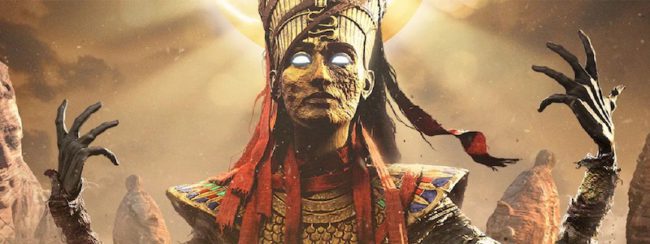
The quick short answer is this – no, the concept of the pharaoh’s curse is a myth.
Some might immediately quip, “But but but, what about Tutankhamun’s curse, that is real … yes?”.
Again no.
Let’s dig into that one to understand what actually happened. It is perhaps the most famous and perhaps best example of a “curse”.
Tutankhamun’s curse
It is indeed true that some of those associated with the discovery and opening of Tutankhamun’s Tomb died. Here is a quick list …
- Lord Carnarvon who helps fund Howard Carter, died of a blood infection about 4 months after the opening of the Tomb.
- He was one of many who entered the opened Tomb. While he died, most who entered were just fine.
- Note also that he did not die when he entered the tomb, but over four months later
- It is also well documented that he had been “prone to frequent and severe lung infections”, his immune system was not exactly firing on all four cylinders. Tomb or no Tomb, in a heath wise sense, Death had this guy in his cross-hairs and was ready to pull the trigger at any moment.
- George Jay Gould I, a visitor to the tomb, died in the French Riviera on 16 May 1923 after he developed a fever following his visit
- He died of pneumonia not pharaoh magic.
- A. C. Mace, a member of Carter’s excavation team, died in 1928 from arsenic poisoning
- The Tomb was opened in 1923, his death was many years later in 1928, so why the connection?
- I visited Stonehenge a couple of years ago. Should my future death be linking to that visit?
- Captain The Hon. Richard Bethell, Carter’s secretary, died on 15 November 1929
- This guy died in bed in a Mayfair club, the victim of a suspected smothering
- And his death is related to the Tomb in what way exactly?
- Howard Carter who opened the tomb in 1923, died quite a bit later on 2 March 1939
- Why exactly is his death in London from cancer at the age of 64 over a decade and a half later attributed to a curse?
Overall many individuals where associated with the opening of the Tomb, and statistically in the decade that followed, you would expect some of them to die.
The vast majority did not, but instead lived long healthy lives.
We don’t need to be vague about this. A study showed that of the 58 people who were present when the tomb and sarcophagus were opened, only eight died within a dozen years. All the others where just fine. Lord Carnarvon‘s daughter who was among the first people to enter the tomb, lived for another 57 years.
You can find the details of all 58 here.
For those that seriously consider that Tutankhamun’s curse is real, they really do need to explain why Tutankhamun was such a crappy ineffective curser.
Why did the Mythology of a Curse go viral?
Two words – Media Hype.
The Newspapers really did need clickbait to sell papers. It earned them money. The result was sexing up stories with tabloid hype was rather common.
According to one article, 26 people associated with the find died within a decade of its discovery. One small flaw is that this never happened. In reality, only six people died during this first decade, the claim is totally bogus.
One newspaper printed a curse reportedly found in the tomb:
“They who enter this sacred tomb shall swift be visited by wings of death.”
Again, nope. The paper made that up. No such inscription was ever found.
The discovery of the Tomb and what it contained was big news. Rightly so, because what was inside was truly amazing. That alone was simply not sufficient for the press, and so much was hyped up to increase interest. It was a time when reporters could simply make stuff up and nobody could really refute it easily. They needed sensationalisation to sell with.
Historical Foundation
Grave robbery was a big fear for the Pharaohs, and so generating cultural fear was to their distinct advantage. Ancient Pharaohs would have had a very strong motivation to nurture fear and ensure such fear was deeply embedded within cultural traditions.
What is true is that unwrapping mummies does expose potentially dangerous mold spores. It is for this reason that archaeologists who unwrap mummies wear protective gear.
That however is not a biological weapon deployed by Pharaohs, just basic biology.
Human Psychology – Pattern Seeking
One other factor in play here is the pattern seeking engine that sits between our ears. A quite natural human cognitive bias is to grasp unrelated points of data and to then pull them together.
If there is already an existing cultural narrative that is then hyped up, you have in effect set the stage. We start to associate unrelated events that appear to confirm what fits the narrative and dismiss anything that conflicts with it.
The ability to seek out patterns and interpret them is something we have been naturally selected for because this skill gave us a distinct survival advantage. [Example: Our distinct ancestors worked out that during dry seasons they should head for the watering hole because that was where they would find all the game to hunt – those that realised that survived]. Unfortunately, this same skill to identify patterns and make sense of them also leads to false positives, hence we also find apparent “evidence” for ghosts, gods, aliens, and in this case a pharaoh’s curse.
Step back and what you find is that it is not really evidence at all. Remember, that most of those, the vast majority of the 58 that first entered the tomb lived long happy lives.
Pharaoh’s Curse Marches on
You might remember recently seeing the march of the Pharoah’s on the news. This is where there was a grand parade of 22 ancient Egyptian royal mummies as they were transferred across the capital, Cairo, on Saturday April 3, 2021. They needed to move them to the new museum, so 18 kings and four queens were transported from the peach-coloured, neo-classical Egyptian Museum to their new resting place 5km (three miles) away.
Some very big names were in the mix. Ramses II, Seti I and Queen Ahmose-Nefertari.
While they could of course simply pop them into the back of a truck and drive them over, they decided to hype it all into a grand PR stunt and so we got this …


Authorities shut down roads along the Nile for this elaborate royal procession dubbed the Golden Parade.
I bet you can see where this is going.
If you guessed “pharaoh’s curse”, then yes indeed. Up pops whispers of the “pharaoh’s curse” on social media. So much so that Egyptian archaeologist Zahi Hawass needed to quickly jump all over it …
“Before the mummies will be walking today in the streets of Cairo things happened in Egypt: the boat in the Suez Canal, also the trains had an accident and a building collapsed. Everyone says this is the curse of the mummy, but I say there is no curse of the mummy, The curse is good for TV, for movies and newspapers, but it’s not true. There’s no curse at all.”
As an Egyptian archaeologist I guess you do have to have a great deal of sympathy for the poor chap. This “pharaoh’s curse” canard is something that most probably hits him on a regular basis. I have visions of his face been beetroot red with all the face-palming that he has done over the years.
It is perhaps inevitable that this “pharaoh’s curse” rubber duck will keep on bouncing up because it has become well and truly embedded into our cultural mythology.
Meanwhile the ancient Pharaoh’s would most probably not be cursing anybody but instead would have been truly delighted to find that after all these centuries they get a golden parade watched by millions all around the planet and are then placed into a special building so that literally millions more can come visit and learn about who they were for the countless years ahead.
That really beats being stuck in the valley of the kings and being completely forgotten.
